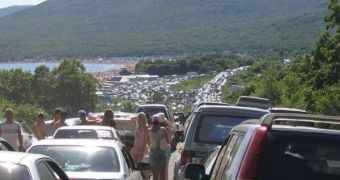You know how, sometimes, you are walking down the street, or driving in your personal car and all of a sudden all the traffic screeches to a halt, right? Sometimes drivers get stuck like this for hours at a time, without seeing the cause of the jam. But, if you go all the way to the place of the possible cause, you might find yourself shocked at the fact that there isn't any. In order to find a possible cause for the mysterious traffic jams, mathematicians from Exeter, Bristol and Budapest developed a mathematical model of the events taking place during such situations.
If you consider for example a highway with two lanes during heavy traffic, and a random event such as a car changing lanes, the models show that the drivers immediately following the respective car would have the tendency of slowing down in order to allow it to make the maneuver. However, the other cars would have to decrease their speeds even more, and soon, a few kilometers in the back of the car column, the traffic will stop altogether without any reason.
Mathematicians calculate that this is most likely to happen while driving on a busy highway that has more than 15 cars per kilometer and will trigger a so-called 'backwards traveling wave' which may provoke a traffic jam lasting for several minutes.
The situation is even more frustrating as these jams apparently have no clear cause. According to the mathematical models, a traffic jam which results in massive delays is usually due to an overreaction of one single driver. The causes of these traffic jams have been mostly a mystery for the last years, and people have preponderantly blamed it on the volume of traffic that increased constantly. The fact is that, although the volume of traffic has a specific role in causing them, it is not the triggering factor.
According to mathematicians, the key is in keeping the traffic flowing smoothly. The sheer volume of cars on a highway does not necessarily trigger a jam. However, the driver's reactions to congested traffic, like heavy braking, can lead to massive delays.
Dr G?bor Orosz explains that while you brake, the traffic will stop several kilometers behind you; however, a slight braking could keep the flow of cars constant, thus avoiding a jam.

 14 DAY TRIAL //
14 DAY TRIAL //